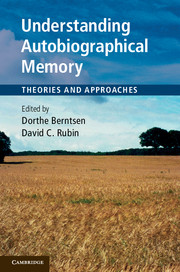Book contents
- Frontmatter
- Contents
- List of figures
- List of tables
- List of contributors
- Preface
- Acknowledgements
- 1 Introduction
- Part I Approaches to the study of autobiographical memory
- Part II Neural studies of autobiographical memory
- Part III Social and cultural aspects of autobiographical memory
- 8 Of sins and virtues: memory and collective identity
- 9 Historically defined autobiographical periods: their origins and implications
- 10 Directive functions of autobiographical memory: theory and method
- Part IV Development of autobiographical memory from infancy to old age
- Part V Evolution and basic processes of autobiographical memory
- Part VI Discussion
- Index
- References
8 - Of sins and virtues: memory and collective identity
Published online by Cambridge University Press: 05 November 2012
- Frontmatter
- Contents
- List of figures
- List of tables
- List of contributors
- Preface
- Acknowledgements
- 1 Introduction
- Part I Approaches to the study of autobiographical memory
- Part II Neural studies of autobiographical memory
- Part III Social and cultural aspects of autobiographical memory
- 8 Of sins and virtues: memory and collective identity
- 9 Historically defined autobiographical periods: their origins and implications
- 10 Directive functions of autobiographical memory: theory and method
- Part IV Development of autobiographical memory from infancy to old age
- Part V Evolution and basic processes of autobiographical memory
- Part VI Discussion
- Index
- References
Summary
Human memory seems ill equipped to handle the multitude of demands placed on it. Schacter (1999) has treated the widely recognized weaknesses of memory as sins, raising an ideal of a “perfect memory.” For him, memory sins against people, and we assume that he would opine that people must simply learn to live with its corruption. They must accept that their memories are transient and perhaps undesirably persistent, and they must realize that memory is vulnerable to absent-mindedness, biases, source-monitoring errors, and the implantation of misinformation. These weaknesses are not what people might want out of their memory, but they are what evolution has provided.
In this volume on autobiographical memory, one might follow Schacter’s lead and ask what the cost of these faulty memories is for identity formation. As Christopher Nolan’s film Memento dramatically illustrates, the cost is no doubt severe. The central character in Memento, Leonard Shelby, struggles with a profound amnesia. This memory failure creates a tentative hold on the past that, as the movie progresses, leads to a slow disintegration of Lenny’s identity. As his nemesis Teddy says: “You don’t . . . know who you are, Lenny.” And indeed, the audience watches as Lenny slips in and out of a slowly emerging realization that he might be a murderer. Although Memento captures the relation between autobiographical memory and identity in extremis, it underscores how the fallibility of memories might make the hold people have on their identity ever so tentative. From this perspective, the flaws of memory might be viewed as cardinal sins.
- Type
- Chapter
- Information
- Understanding Autobiographical MemoryTheories and Approaches, pp. 141 - 159Publisher: Cambridge University PressPrint publication year: 2012
References
- 10
- Cited by

